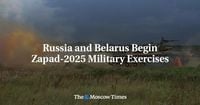On September 12, 2025, the landscape of Eastern Europe shifted once again as Russia and Belarus launched the Zapad-2025 joint military drills—a move that has reignited anxiety along NATO’s eastern flank just days after Russian drones breached Polish airspace. With memories still fresh of the last time such maneuvers preceded a full-scale invasion of Ukraine, officials and analysts across the continent are watching with a mix of apprehension and calculation, searching for clues in these war games about Moscow’s intentions and the region’s security future.
The Zapad-2025 exercises, set to run until September 16, are being staged across Belarus and Russia, stretching from the Moscow and Leningrad military districts to the Kaliningrad exclave, the Arctic, and the Baltic and Barents seas, according to RFE/RL. Yet, unlike the massive drills of 2021 that involved some 200,000 troops, this year’s iteration is markedly scaled back. Belarusian defense officials, as cited by both FRANCE 24 and RFE/RL, revised their initial estimate of 13,000 troops down to around 7,000–8,000 in May, a move widely attributed to Russia’s ongoing war of attrition in Ukraine. Moscow itself is only expected to send about 2,000 troops to Belarus for the event.
Most of the maneuvers are concentrated near Barysau, a city approximately 74 kilometers northeast of Minsk, though small units are set to conduct practical tasks in areas close to the Polish and Lithuanian borders. Belarusian Defense Minister Viktor Khrenin emphasized that the bulk of the drills would occur far from the country’s western edges, a gesture perhaps intended to ease the nerves of neighboring NATO states. Still, the proximity of some exercises to Poland and Lithuania—countries that have been outspoken about their security concerns—has done little to calm regional unease.
The timing and context of these drills are impossible to ignore. The last joint exercises between Russia and Belarus in February 2022 were followed almost immediately by Russia’s invasion of Ukraine, with many troops crossing from Belarusian territory. This precedent is not lost on NATO members, especially Poland and Lithuania. “Zapad means ‘West’ in Russian, and these drills obviously have Western officials very worried because of what happened the last time Moscow and Minsk held joint war games,” FRANCE 24’s Brussels correspondent David Keating reported.
Adding to the tension, on September 10, fewer than 20 Russian drones—made of polystyrene and costing about $10,000 each—entered Polish airspace, prompting Warsaw to close air traffic along its borders with Belarus and Ukraine up to an altitude of three kilometers until December 9. NATO scrambled a multinational force, including F-35 and F-16 fighter jets, helicopters, and Patriot defense systems, but managed to shoot down only three drones. The incident exposed what some analysts have called a “price-per-shot problem.” French Admiral Pierre Vandier, head of NATO’s Allied Command Transformation, remarked last year, “If we fire $1 million missiles at $10,000 targets, one day, we will lose.”
Poland’s Prime Minister Donald Tusk described the coming drills as “very aggressive” and pointed to the Suwalki Gap—a strategic corridor separating Belarus from Russia’s Kaliningrad exclave—as a key target of concern. In anticipation, Poland closed its border with Belarus and, along with Lithuania and Germany, began its own military exercises. According to Ryhor Nizhnikau of the Finnish Institute of International Affairs, such moves are as much about reassuring their own populations as they are about preparing for real conflict. “These exercises serve mostly political goals, aiming to demonstrate to the Polish and Baltic publics that they are being protected,” he explained to FRANCE 24.
Yet, the reduced scale of Zapad-2025 has not gone unnoticed. “Right now, Moscow cannot send the tens of thousands of troops to Belarus that would be needed to pose a credible threat to countries on NATO’s eastern flank,” Nizhnikau noted. Still, he warned, “The idea that Russia may one day use Zapad drills to strike at countries on NATO’s eastern flank is indeed credible—particularly if it attains its goals in Ukraine and frees up military resources. But not this time.”
What truly sets this year’s drills apart is their nuclear component. Following a December 2024 treaty, Belarus now sits under Russia’s nuclear umbrella, and President Alexander Lukashenko has declared his country possesses several dozen tactical nuclear weapons. Defense Minister Khrenin confirmed that troops would practice “planning the use of” Russian nuclear weapons and nuclear-capable intermediate range missiles during the exercises. However, he clarified that no actual deployment would occur. According to RFE/RL, the drills are as much about projecting power and influence as they are about military readiness. “This is a display for nations and world media as part of their influence campaign,” said Lance Landrum, a retired U.S. Air Force Lieutenant General now at the Center for European Policy Analysis.
Western officials, meanwhile, are treading a careful line. A NATO spokesperson told RFE/RL that the alliance is monitoring Russian military activity closely and has called on “Russia and Belarus to act in a predictable and transparent manner in line with their international commitments.” While noting that NATO does “not see any immediate military threat” to its members, the spokesperson added, “The Kremlin has consistently demonstrated a lack of transparency, including with regard to the size and scope of its exercises. It has a known history of using military exercises to pursue coercive policies.”
In the background, Belarus’s President Lukashenko has signaled a tentative willingness to thaw relations with the West after years of isolation due to his crackdown on dissent and support for Russia’s war in Ukraine. This year, he has overseen the release of political prisoners and even spoken by phone with U.S. President Donald Trump, who referred to him as a “highly respected President” on social media. As Ryhor Astapenia of Chatham House observed, “If these exercises proceed in a dull and transparent manner, they will likely pave the way for further dialogue.”
Despite the reassuring words, the recent drone incursion and the swift but costly NATO response have exposed vulnerabilities. Phillips P. O’Brien, a professor at St Andrews University, wrote that the drones should have been identified as possible threats long before they entered Polish airspace. “NATO states, even frontline ones, have clearly not prepared for war of the type that is happening now,” he noted.
For Russian President Vladimir Putin, the Zapad-2025 drills serve multiple purposes: to demonstrate to the world that Russia’s military remains formidable despite over a million estimated casualties in Ukraine, to test NATO’s resolve, and to potentially divert Western resources away from Kyiv. As Dafydd Townley of the University of Portsmouth put it, “This is Putin testing his boundaries, testing NATO’s resolve, and indicating to NATO member states and the US that he has no intention of sitting down for talks with the Ukrainians.”
As the Zapad-2025 drills unfold, the world watches not just for tanks and missiles, but for signals—subtle or otherwise—about what comes next. In this tense chess game, every move is scrutinized, and the stakes remain as high as ever.




